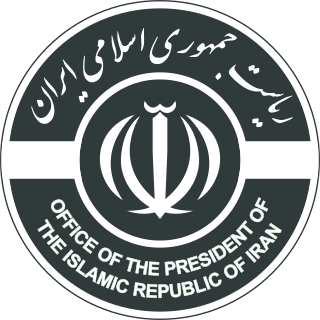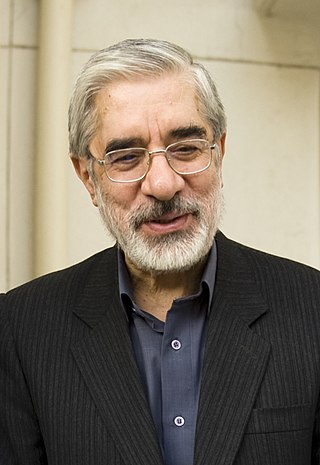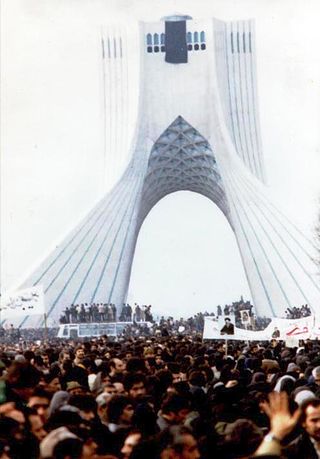
The Government of Mohammad-Ali Rajai was the first government of Iran after the Iranian Revolution. At that time, Abolhassan Banisadr was president and Mohammad-Ali Rajai was prime minister.

The Government of Mohammad-Ali Rajai was the first government of Iran after the Iranian Revolution. At that time, Abolhassan Banisadr was president and Mohammad-Ali Rajai was prime minister.
He was elected to a four-year term as president on 25 January 1980, receiving 78.9 percent of the vote in a competitive election against Ahmad Madani, Hassan Habibi, Sadegh Tabatabaee, Dariush Forouhar, Sadegh Ghotbzadeh, Kazem Sami, Mohammad Makri, Hassan Ghafourifard, and Hassan Ayat, and inaugurated on 4 February. Khomeini remained the Supreme Leader of Iran, with the constitutional authority to dismiss the President. The inaugural ceremonies were held at the hospital where Khomeini was recovering from a heart ailment. [1]
Banisadr was not an Islamic cleric; Khomeini had insisted that clerics should not run for positions in the government. In August and September 1980, Banisadr survived two helicopter crashes near the Iranian border with Iraq.
Banisadr soon fell out with Khomeini, who reclaimed the power of Commander-in-Chief on 10 June 1981.
After the Iranian Revolution in 1979, he became Minister of Education in the Interim Government of Mehdi Bazargan. When Abolhassan Banisadr was elected as president, The parliament elected him as the new prime minister. He was prime minister of Islamic Republic of Iran from 1980 to 1981. He was also Minister of Foreign Affairs for five months, 11 March 1981 to 15 August 1981, while he was Prime Minister.
During the nomination process, there were serious tensions between Rajai and Banisadr due to the latter's objections over the candidates. [2]
List of members of Rajai's cabinet was as follows:
| Ministry | Minister |
|---|---|
| President | Abolhassan Banisadr |
| Prime Minister | Mohammad-Ali Rajai |
| Agricultural | Mohammad Salamati |
| Commerce | Hossein Kazempur |
| Post | Mahmoud Ghandi |
| Culture and Islamic Guidance | Abbas Duzduzani |
| Defense and Armed Forces Logistics | Javad Fakoori |
| Economy | Hossein Namazi |
| Education | Mohammad-Javad Bahonar |
| Energy | Hassan Abbaspur |
| Foreign Affairs | Karim Khodapanahi Mohammad-Ali Rajai (acting) Mir-Hossein Mousavi |
| Health | Hadi Manafi |
| Housing and Urban Development | Mohammad-Shahab Gonabadi |
| Industries | Mohammad-Reza Ne'matzadeh |
| Interior | Mohammad-Reza Mahdavi Kani |
| Justice | Ebrahim Ahadi |
| Labour and Social Affairs | Mir-Mohammad Sadeghi |
| Petroleum | Mohammad Javad Tondguyan |
| Roads | Mousa Kalantary |
| Science and Culture | Hassan Arefi |

The president of Iran is the head of government of the Islamic Republic of Iran. He is the second highest-ranking official, after the Supreme Leader. The first election was held in 1980 and Abulhassan Banisadr won. Mohammad Mokhber, the first vice president, is acting as president following the death of Ebrahim Raisi on 19 May 2024.

Mohammad-Ali Rajai was the second president of Iran from 2 August 1981 until his death. He served also as prime minister under Abolhassan Banisadr. In addition, Rajai was minister of foreign affairs from 11 March 1981 to 15 August 1981, while he was prime minister. He was assassinated in a bombing on 30 August 1981 along with prime minister Mohammad-Javad Bahonar.

Seyyed Abolhassan Banisadr was an Iranian politician, writer, and political dissident. He was the first president of Iran after the 1979 Iranian Revolution abolished the monarchy, serving from February 1980 until his impeachment by parliament in June 1981. Prior to his presidency, he was the minister of foreign affairs in the interim government. He had resided for many years in France where he co-founded the National Council of Resistance of Iran.

Mohammad-Javad Bahonar was a Shia Iranian theologian and politician who served as the Prime Minister of Iran for less than one month in August 1981. Bahonar and other members of Mohammad-Ali Rajai's government were assassinated by Mujahideen-e Khalq.

Mir-Hossein Mousavi Khameneh is an Iranian reformist politician, artist and architect who served as the 49th and last Prime Minister of Iran from 1981 to 1989. He was a reformist candidate for the 2009 presidential election and eventually the leader of the opposition in the post-election unrest. Mousavi served as the president of the Iranian Academy of Arts until 2009, when conservative authorities removed him. Although Mousavi had always considered himself a reformist and believed in promoting change within the 1979 Revolution constitution, on 3 Feb 2023, in response to the violent suppression of Iranians by Ali Khamenei, the Supreme Leader of Iran, he announced opposition to the Islamic Republic constitution and asked for a widespread referendum to fully change the constitution and make a fundamental change in Iran's political system.

The prime minister of Iran was a political post that had existed in Iran (Persia) during much of the 20th century. It began in 1906 during the Qajar dynasty and into the start of the Pahlavi dynasty in 1923 and into the 1979 Iranian Revolution before being abolished in 1989.

Sadegh Ghotbzadeh was an Iranian politician who served as a close aide of Ayatollah Khomeini during his 1978 exile in France and was foreign minister during the Iran hostage crisis following the Iranian Revolution. In 1982, he was executed for allegedly plotting the assassination of Ayatollah Khomeini and the overthrow of the Islamic Republic.
Presidential elections were held for the first time in Iran on 25 January 1980, one year after the Iranian Revolution when the Council of the Islamic Revolution was in power. Abolhassan Banisadr was elected president with 76% of the vote.
Presidential elections were held in Iran on 24 July 1981 after the previous Iranian president, Abolhassan Banisadr, was impeached by the Majlis on 21 June and then sacked by the Supreme Leader, Ayatollah Khomeini, on 22 June. The elections occurred after the Hafte Tir bombing, which killed Mohammad Beheshti and dozens of other Iranian officials on 28 June 1981. This led to the election of Mohammad Ali Rajai, the previous prime minister, winning 13,001,761 votes out of the 14,573,803 votes cast, which was 89% of the votes. The vote turnout was 65.29%.

Ayatollah Mohammad Reza Mahdavi Kani was an Iranian Shia cleric, writer and conservative and principlist politician who was Prime Minister of Iran from 2 September until 29 October 1981. Before that, he was Minister of Interior in the cabinets of Mohammad-Ali Rajai and Mohammad-Javad Bahonar. He was the leader of Combatant Clergy Association and Chairman of the Assembly of Experts and also founder and president of Imam Sadiq University.

The Council of the Islamic Revolution was a group formed by Ayatollah Ruhollah Khomeini to manage the Iranian Revolution on 10 January 1979, shortly before he returned to Iran. "Over the next few months there issued from the council hundreds of rulings and laws, dealing with everything from bank nationalization to nurses' salaries." Its existence was kept a secret during the early, less secure time of the revolution, and its members and the exact nature of what the council did remained undisclosed to the public until early 1980. Some of the council's members like Motahhari, Taleqani, Bahonar, Beheshti, Qarani died during Iran–Iraq War or were assassinated by the MKO during the consolidation of the Iranian Revolution. Most of those who remained were put aside by the regime.

This article is a timeline of events relevant to the Islamic Revolution in Iran. For earlier events refer to Pahlavi dynasty and for later ones refer to History of the Islamic Republic of Iran. This article doesn't include the reasons of the events and further information is available in Islamic revolution of Iran.
Following the Iranian Revolution, which overthrew the Shah of Iran, in February 1979, Iran was in a "revolutionary crisis mode" from this time until 1982 or 1983 when forces loyal to the revolution's leader, Ayatollah Ruhollah Khomeini, consolidated power. During this period, Iran's economy and the apparatus of government collapsed; its military and security forces were in disarray.

The Cabinet of Iran is a formal body composed of government officials, ministers, chosen and led by the President of Iran. Its composition must be approved by a vote in parliament. According to the Constitution of the Islamic Republic of Iran, a president may dismiss members of the cabinet, but must do so in writing, and new appointees must again be approved by parliament. The cabinet meets weekly on Saturdays in Tehran. There may be additional meetings as circumstances require. The president chairs them. The Supreme Leader of Iran Ali Khamenei has the power to dismiss cabinet members like ministers, vice presidents and presidents at any time, regardless of parliamentary decisions.
Premiership of Mir-Hossein Mousavi were the third and fourth government of Iran after the Iranian Revolution. At that time, Ali Khamenei was the president.
The Government of Mohammad-Javad Bahonar was the second government of Iran after the Iranian Revolution. During that time, Mohammad-Ali Rajai was president and Mohammad-Javad Bahonar was prime minister.
The following lists events that happened during 1981 in Iran.
Events from the year 1980 in Iran.

The position of Commander-in-Chief (Farmandehe Koll-e Qova, formerly known as Bozorg Arteshtārān is the ultimate authority of all the Armed Forces of Iran, and the highest possible military position within the Islamic Republic of Iran. The position was established during the Persian Constitutional Revolution. According to the Constitution of Iran, the position is vested in the Supreme Leader of Iran and is held since 1981.